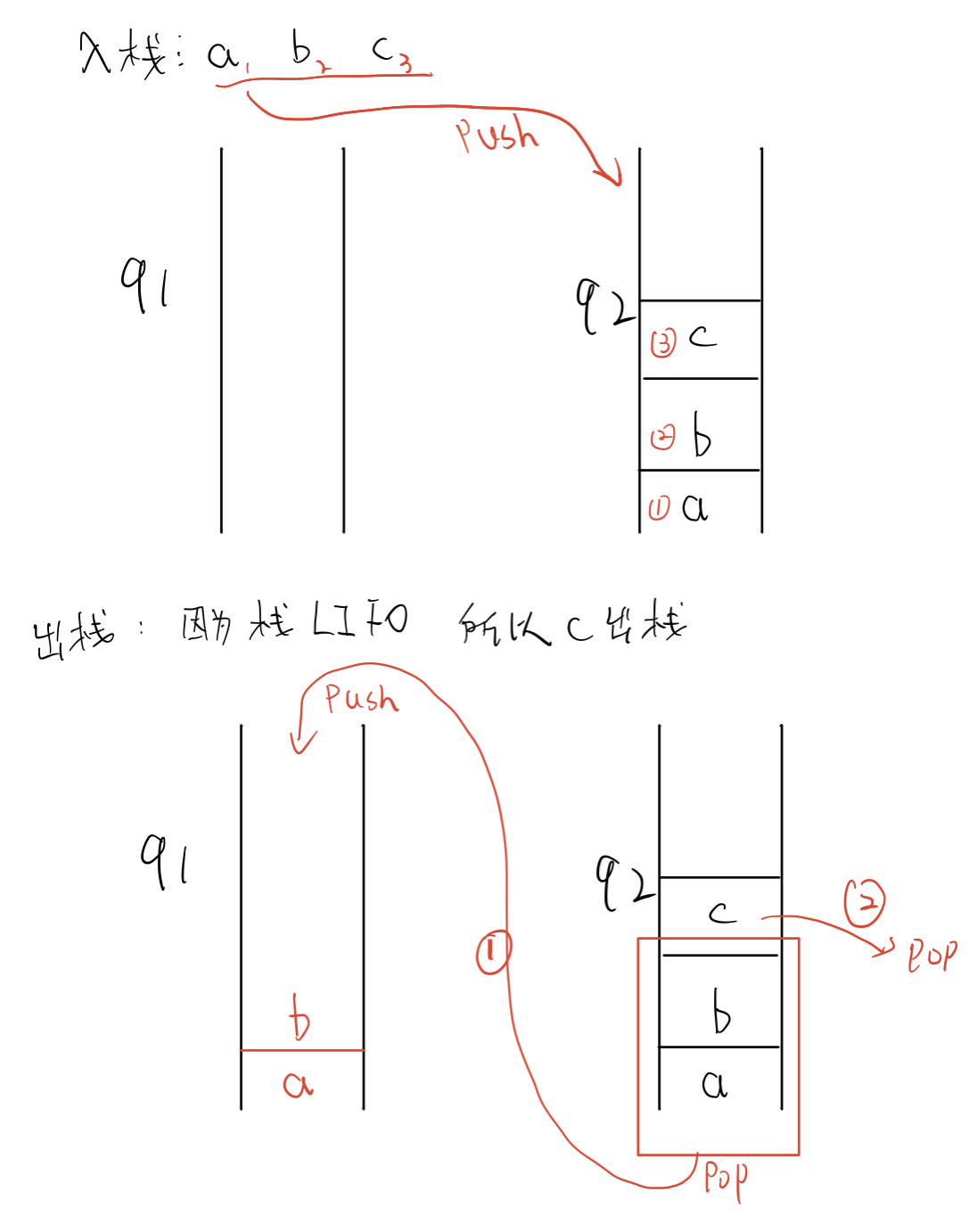[算法] leetcode栈与队列相关题目详解
Posted 哦哦呵呵
tags:
篇首语:本文由小常识网(cha138.com)小编为大家整理,主要介绍了[算法] leetcode栈与队列相关题目详解相关的知识,希望对你有一定的参考价值。
leetcode栈与队列相关题目详解
目录
1. leetcode 225_用队列实现栈
题目描述
请你仅使用两个队列实现一个后入先出(LIFO)的栈,并支持普通队列的全部四种操作(push、top、pop 和 empty)。
实现 MyStack 类:
void push(int x) 将元素 x 压入栈顶。
int pop() 移除并返回栈顶元素。
int top() 返回栈顶元素。
boolean empty() 如果栈是空的,返回 true ;否则,返回 false 。
注意:
你只能使用队列的基本操作 ―― 也就是 push to back、peek / pop from front、size 和 is empty 这些操作。
你所使用的语言也许不支持队列。 你可以使用 list (列表)或者 deque(双端队列)来模拟一个队列, 只要是标准的队列操作即可。
示例:
输入:
["MyStack", "push", "push", "top", "pop", "empty"]
[[], [1], [2], [], [], []]
输出:
[null, null, null, 2, 2, false]
解释:
MyStack myStack = new MyStack();
myStack.push(1);
myStack.push(2);
myStack.top(); // 返回 2
myStack.pop(); // 返回 2
myStack.empty(); // 返回 False
提示:
1 <= x <= 9
最多调用100 次 push、pop、top 和 empty
每次调用 pop 和 top 都保证栈不为空
https://leetcode-cn.com/problems/implement-stack-using-queues/
解题思路
需要使用两个队列模拟实现栈。
入栈时,判断哪个队列不空,将元素放入不空的队列中。
出栈时,判断哪个队列中有元素,将有元素的队列前 N-1个元素放入另外一个队列中,最后队剩余元素出队。

代码实现
typedef struct {
Queue q1;
Queue q2;
} MyStack;
/** Initialize your data structure here. */
MyStack* myStackCreate() {
MyStack* stack = (MyStack*)malloc(sizeof(MyStack));
if (stack == NULL)
return NULL;
QueueInit(&stack->q1);
QueueInit(&stack->q2);
return stack;
}
/** Push element x onto stack. */
void myStackPush(MyStack* obj, int x) {
if (!QueueEmpty(&obj->q1))
{
QueuePush(&obj->q1, x);
}
else
{
QueuePush(&obj->q2, x);
}
}
/** Removes the element on top of the stack and returns that element. */
int myStackPop(MyStack* obj) {
int data = 0;
// q1不空将前 n-1 个元素搬移到q2
if (!QueueEmpty(&obj->q1))
{
while (QueueSize(&obj->q1) > 1)
{
QueuePush(&obj->q2, QueueFront(&obj->q1));
QueuePop(&obj->q1);
}
data = QueueFront(&obj->q1);
QueuePop(&obj->q1);
}
else
{
while (QueueSize(&obj->q2) > 1)
{
QueuePush(&obj->q1, QueueFront(&obj->q2));
QueuePop(&obj->q2);
}
data = QueueFront(&obj->q2);
QueuePop(&obj->q2);
}
return data;
}
/** Get the top element. */
int myStackTop(MyStack* obj) {
if (!QueueEmpty(&obj->q1))
{
return QueueBack(&obj->q1);
}
return QueueBack(&obj->q2);
}
/** Returns whether the stack is empty. */
bool myStackEmpty(MyStack* obj) {
return QueueEmpty(&obj->q1) && QueueEmpty(&obj->q2);
}
void myStackFree(MyStack* obj) {
QueueDestroy(&obj->q2);
QueueDestroy(&obj->q1);
free(obj);
}
2. leetcode 232_用栈实现队列
题目描述
请你仅使用两个栈实现先入先出队列。队列应当支持一般队列支持的所有操作(push、pop、peek、empty):
实现 MyQueue 类:
void push(int x) 将元素 x 推到队列的末尾
int pop() 从队列的开头移除并返回元素
int peek() 返回队列开头的元素
boolean empty() 如果队列为空,返回 true ;否则,返回 false
说明:
你只能使用标准的栈操作 ―― 也就是只有 push to top, peek/pop from top, size, 和 is empty 操作是合法的。
你所使用的语言也许不支持栈。你可以使用 list 或者 deque(双端队列)来模拟一个栈,只要是标准的栈操作即可。
示例:
输入:
["MyQueue", "push", "push", "peek", "pop", "empty"]
[[], [1], [2], [], [], []]
输出:
[null, null, null, 1, 1, false]
解释:
MyQueue myQueue = new MyQueue();
myQueue.push(1); // queue is: [1]
myQueue.push(2); // queue is: [1, 2] (leftmost is front of the queue)
myQueue.peek(); // return 1
myQueue.pop(); // return 1, queue is [2]
myQueue.empty(); // return false
提示:
1 <= x <= 9
最多调用 100 次 push、pop、peek 和 empty
假设所有操作都是有效的 (例如,一个空的队列不会调用 pop 或者 peek 操作)
https://leetcode-cn.com/problems/implement-queue-using-stacks/
解题思路
该题与上题思路基本一致,同样采用两个栈实现。
入队列时:直接向其中一个栈入栈。
出队列时:检测另一个栈是否有元素,有元素则出栈,没有元素则将s1元素导入至s2中,并队栈顶出栈。
代码实现
typedef struct {
Stack s1;
Stack s2;
} MyQueue;
/** Initialize your data structure here. */
MyQueue* myQueueCreate() {
MyQueue* queue = (MyQueue*)malloc(sizeof(MyQueue));
if (NULL == queue)
return NULL;
StackInit(&queue->s1);
StackInit(&queue->s2);
return queue;
}
/** Push element x to the back of queue. */
void myQueuePush(MyQueue* obj, int x) {
assert(obj);
StackPush(&obj->s1, x);
}
/** Removes the element from in front of queue and returns that element. */
int myQueuePop(MyQueue* obj) {
assert(obj);
DataType data = 0;
if (StackEmpty(&obj->s2))
{
while (StackSize(&obj->s1) > 0)
{
StackPush(&obj->s2, StackTop(&obj->s1));
StackPop(&obj->s1);
}
// 出栈
data = StackTop(&obj->s2);
StackPop(&obj->s2);
}
else
{
data = StackTop(&obj->s2);
StackPop(&obj->s2);
}
return data;
}
/** Get the front element. */
int myQueuePeek(MyQueue* obj) {
// 如果s1不为空并且s2不为空,则代表刚入栈完成,所以要将s1的元素搬移至s2,并输出栈顶元素
if (!StackEmpty(&obj->s1) && StackEmpty(&obj->s2))
{
while (StackSize(&obj->s1))
{
StackPush(&obj->s2, StackTop(&obj->s1));
StackPop(&obj->s1);
}
return StackTop(&obj->s2);
}
return StackTop(&obj->s2);
}
/** Returns whether the queue is empty. */
bool myQueueEmpty(MyQueue* obj) {
return StackEmpty(&obj->s1) && StackEmpty(&obj->s2);
}
void myQueueFree(MyQueue* obj) {
StackDestroy(&obj->s1);
StackDestroy(&obj->s2);
free(obj);
}
3. leetcode 622_设计循环队列
题目描述
设计你的循环队列实现。 循环队列是一种线性数据结构,其操作表现基于 FIFO(先进先出)原则并且队尾被连接在队首之后以形成一个循环。它也被称为“环形缓冲器”。
循环队列的一个好处是我们可以利用这个队列之前用过的空间。
在一个普通队列里,一旦一个队列满了,我们就不能插入下一个元素,
即使在队列前面仍有空间。但是使用循环队列,我们能使用这些空间去存储新的值。
你的实现应该支持如下操作:
MyCircularQueue(k) : 构造器,设置队列长度为 k 。
Front : 从队首获取元素。如果队列为空,返回 - 1 。
Rear : 获取队尾元素。如果队列为空,返回 - 1 。
enQueue(value) : 向循环队列插入一个元素。如果成功插入则返回真。
deQueue() : 从循环队列中删除一个元素。如果成功删除则返回真。
isEmpty() : 检查循环队列是否为空。
isFull() : 检查循环队列是否已满。
示例:
MyCircularQueue circularQueue = new MyCircularQueue(3); // 设置长度为 3
circularQueue.enQueue(1); // 返回 true
circularQueue.enQueue(2); // 返回 true
circularQueue.enQueue(3); // 返回 true
circularQueue.enQueue(4); // 返回 false,队列已满
circularQueue.Rear(); // 返回 3
circularQueue.isFull(); // 返回 true
circularQueue.deQueue(); // 返回 true
circularQueue.enQueue(4); // 返回 true
circularQueue.Rear(); // 返回 4
提示:
所有的值都在 0 至 1000 的范围内;
操作数将在 1 至 1000 的范围内;
请不要使用内置的队列库。
https://leetcode-cn.com/problems/design-circular-queue/
解题思路
利用数组实现循环队列,具体思路点击 队列与循环队列。
代码实现
typedef int DataType;
typedef struct {
DataType* data;
int front;
int rear;
int size;
int count;
} MyCircularQueue;
MyCircularQueue* myCircularQueueCreate(int k) {
MyCircularQueue* mcq = (MyCircularQueue*)malloc(sizeof(MyCircularQueue));
if (NULL == mcq)
{
return NULL;
}
mcq->data = (DataType*)malloc(k * sizeof(DataType) + 1);
if (NULL == mcq->data)
{
return NULL;
}
mcq->front = mcq->rear = 0;
mcq->size = k;
mcq->count = 0;
return mcq;
}
bool myCircularQueueIsEmpty(MyCircularQueue* obj) {
if (obj->count == 0)
{
return true;
}
return false;
}
bool myCircularQueueIsFull(MyCircularQueue* obj) {
if (obj->count == obj->size)
{
return true;
}
return false;
}
bool myCircularQueueEnQueue(MyCircularQueue* obj, int value) {
if (myCircularQueueIsFull(obj))
{
return false;
}
if (obj->rear == obj->size)
obj->rear = 0;
obj->data[obj->rear++] = value;
obj->count++;
return true;
}
bool myCircularQueueDeQueue(MyCircularQueue* obj) {
if (myCircularQueueIsEmpty(obj))
return false;
if (obj->front == obj->size)
obj->front = 0;
else
obj->front++;
obj->count--;
return true;
}
int myCircularQueueFront(MyCircularQueue* obj) {
if (myCircularQueueIsEmpty(obj))
return -1;
return obj->data[obj->front];
}
int myCircularQueueRear(MyCircularQueue* obj) {
if (myCircularQueueIsEmpty(obj))
return -1;
return obj->data[obj->rear - 1];
}
void myCircularQueueFree(MyCircularQueue* obj) {
free(obj->data);
obj->data = NULL;
}
以上是关于[算法] leetcode栈与队列相关题目详解的主要内容,如果未能解决你的问题,请参考以下文章
LeetCode与《代码随想录》栈与队列篇:做题笔记与总结-JavaScript版